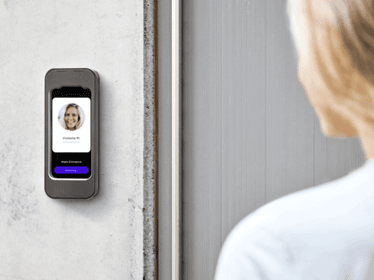Access control systems lay the foundation for multifamily properties and apartment buildings to enable fundamental services and amenities for both tenants and management. So, it’s critical that the systems facilitating physical access are not only operating as they should but working seamlessly to create better living experiences for residents and a more efficient environment for property managers.
With recent advancements in access control technology, both new developments and existing properties are looking for the best way to cut costs, generate revenue, improve operations, and most importantly, build a better, more secure place to live.
In this interview, Mill Creek Residential Chief Information and Innovation Officer Jeff Kok, explains the criteria for evaluating access control technology, and how modern physical security solutions are future-proofing communities.
Table of contents
- Criteria for Evaluating Access Control Technology
- The Benefits of Upgrading to Smart Access
- Retrofitting Modern Access Control Systems in Existing Buildings
- The Future of Multifamily Access Control
Related posts
- The Future of Access Control
- Everything Property Managers Need to Know About Proptech
- How Modern Access Control is Changing the Tenant Experience
Criteria for Evaluating Access Control Technology
Mill Creek Residential manages over 20,000 units with over 10,000 more in their growing pipeline. Their major success can be attributed in part to the way they embrace innovation and technology.
Their evaluation of new technology, including access control systems, asks four main questions which can be used to assess the new solutions being considered for your building:
- Does it generate revenue?
- Does it cut costs?
- Does it improve the resident experience?
- Does it tie into their Environmental, Social, and Governance (ESG) strategy?
Does It Generate Revenue?
“Access control is unique in the fact that it meets all four criteria,” Kok said.
“Generating revenue is number one. You have to understand by itself does it really generate revenue or it is part of a holistic system of technology that you’re providing. So there are two different ways of looking at it. First, can I command higher rent? Because I have an upgraded access system or a higher end product, I’ll collect higher rent. But that’s a very difficult statistic to track. The second way to look at it is if it’s part of a technology bundle. That’s a lot more attainable to quantify and track, so you’re able to show exactly what your revenue did.
“We are seeing different markets where smart access folds into our technology bundle that gets rolled up into the actual pro forma and how we value the asset. From an asset valuation side, we’re seeing a higher asset valuation, but also from a net operating income (NOI) side we’re seeing a benefit because there may be some potential revenue opportunities tied to the total package. We’re not doing a technology package that’s access control by itself. It typically has a bunch of other things included in it like internet or thermostat control. It’s more of a broader experience that provides the opportunity while still providing the resident a cost savings. We buy in bulk and offer it to the resident at a lower cost than they could get in the marketplace on their own because of our buying power.”
Does It Cut Costs?
“Tying access control into a whole smart building initiative with things that make residents’ lives simpler while driving cost savings is really what we would be after to drive revenue.”
“The cost is then saving your maintenance staffer’s time to issue keys and credentials. You’re also streamlining other services that come into the building. Residents can get services into the buildings such as package delivery or food delivery. Self-touring is another. There’s a lot of benefit to having that face to face interaction however, there’s people that want to see on their time. And what do you do on the weekends if you want to give your leasing staff time off? So, self-touring is a great enabler to do both of those and satisfy the prospect’s need to come into the building.“
Does It Improve the Resident Experience?
“Third, which I think is a no-brainer, definitely enhances the resident experience and makes their life simpler. It gives them the control so instead of needing to ask for another key if a friend is visiting one weekend, or asking for access for the cleaner or dog walker while they’re at work. Now, they’re in control to do all that and think about all that time savings that come back to your staff.”
Does It Tie Into ESG Strategy?
“From an ESG perspective, you could be putting something in that’s more sustainable from an access control perspective, but it could also tie to resident wellness. Let’s think through the sustainability initiatives: the type of locks and how they’re manufactured or where they come from or what materials are in them make them a sustainable product. The building itself becomes a sustainable product in and of itself.”
The Benefits of Upgrading to Smart Access
Many multifamily communities, including Mill Creek, are re-thinking the access strategy across their buildings. And for good reason. Not only does it make financial sense to upgrade to smart access, it also benefits property managers and tenants.
Below, Kok describes the main benefits that come with upgrading to a smart, integrated access control system.
Tenant Satisfaction and Guest Access
“The biggest benefit that we’re seeing is resident satisfaction.
“We’re seeing the use of mobile credentials go up at our smart access communities, so residents are just more satisfied in the fact that they have a simple access solution that they can send a code to their guests and their guests can come in through the video entry system.”
“There are going to be people that order online groceries, need guest services and delivery type products to their homes. Those are fundamental needs that drive access. It’s really important for us to remember that access is an enabler. Providing access to someone on the fly is a necessity for people.”
Simplified Operations for Property Managers
“Another benefit is the simplicity for operations staff. They love being able to have one credential to control all the systems and one database that hosts everyone’s information to be able to provide access to them. Instead of having to go into multiple different systems and create a key, it’s all automated. That alleviates them from other tasks that they previously had to do and led them to focus on the main tasks we hired them for, which is leasing or service maintenance and less focus on key management.”
Informed Decision-Making Through Access Data
“That [using physical access data to inform decision-making] is a developing area.
“Data privacy is incredibly important. We need to be able to aggregate that data so that it’s anonymized and not specific to one any one individual while being able to look at it and say, this door is the most utilized door in the building, this is the door that’s used the most frequently in the common areas, and this is the highest utilization time for the fitness center. Some of that data is relevant to decision making about where many of these spaces go, not only in that current operating asset but in future design of other assets.
“We’re at the early stages of materializing that and making sure that we follow proper data privacy protocols because we’re very sensitive to that. But there’s opportunities there about where we stick amenities and how many of them are utilized.”
Retrofitting Modern Access Control Systems in Existing Buildings
New building developments have the advantage of specifying the modern access control solutions on the market today. Existing multifamily buildings with legacy access systems, however, don’t have that luxury. They need to be incredibly strategic about implementing new solutions and creating a retrofit plan with a clearly defined outcome and budget.
Planning for a Retrofit
When developing a retrofit strategy, Kok says the appropriate steps need to be taken by asking:
- What am I trying to connect?
- Am I trying to give the residents access to just their home unit lock or am I trying to create a completely seamless experience from building entry through the common area through elevator into home entry?
- What needs to be replaced versus what can I use today?
“That takes a lot of design work and analysis. You need to understand where the current wires are, pathways in the building, types of systems and locks.
“There’s a lot of work to be done in retrofits but it’s important to take it piece by piece and think about what experience you’re trying to push forward. If you’re just upgrading to upgrade without thinking about the overall experience, it will not be beneficial or financially make sense. Once that’s decided, the biggest consideration for a retrofit is understanding the cycle of the asset, when renovation money is available, and how much that is.”
Budgeting for a Retrofit
“When going into a retrofit, you have to get creative depending on how the assets are designed, what you already have available, and what systems are in place? If you have an old legacy system in place then it’s going to need to be upgraded or replaced. But, let’s say you have some sort of a Schlage lock or a Yale lock. It may be able to be integrated into a system with Z wave, Zigbee or over WiFi to connect them together or to be able to feed data to them.
“Fundamentally, there are two categories of cost. CAPEX cost is what you have to pay up front just to deliver the solution. That includes the hardware, like the locks, and the installation which could include rewiring or other costs tied into just the project implementation. Outside of costs, this includes picking vendors and manufacturers.
“Second are OPEX costs. A lot of people forget the ongoing cost. All these solutions provide a software access or an application that the resident can use to get access or to give access to someone, and there’s an ongoing monthly cost tied to those. Being able to keep those costs low are beneficial to the operator and how it ties to their NOI. Knowing what those costs are ahead of time, knowing what you’re willing to pay and negotiate, and thinking about scale in those situations really helps negotiate contracts that give you a fair price that helps you then go forward and implement the solution.”
The Future of Multifamily Access Control
There is much to be said about the customer experience for access and enabling streamlined access not only for tenants but their guests and deliveries. So, the questions that building owners and operators are asking are, what are the tech solutions that are working to enable that experience? And how can those be improved today?
“There’s a lot of people that are moving into this space that are trying to bring a different edge to the type of products that they have, but what it really is today is a group of integrations. It’s integrating different product lines together to create a holistic solution, because not everyone’s the manufacturer. There are a few out there now that are actually manufacturing their product, developing the operating system to control said product and the resident experience of that product feature set, but doesn’t have every piece of the pie yet. The industry is still evolving to that point.
“When you think about the pie you think about building access, guest entry access, common entry access, unit access, garage access. A lot of them are different entry systems that are integrated into one to create that seamless experience, but long term, we’ll start seeing one provider controlling all of that or having the set of integrations in place, or they’re actually manufacturing the product.
“Integrations are great, and the world lives on them today, but we all know that integrations are not better than one single solution that’s fully functional together. So if you were to manufacture the video access for guests, the physical lock on the door to open it, as well as the common area and the controls that allow you through the common area into the elevator, plus that is the same product on the common area doors and the unit doors, that’s a lot stronger of an offering. It’s difficult to get there though because it’s a bleed between a manufacturing company and a technology company. You have to create the software that runs it, controls it, and you have to manufacture hardware, including maintaining warranties, fire rating, and UL rating. It becomes difficult to marry the two together really well because so many people want to be just a software company or a manufacturing company.”




